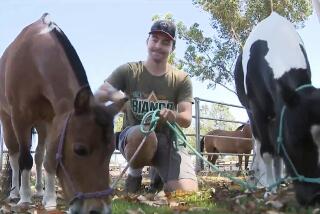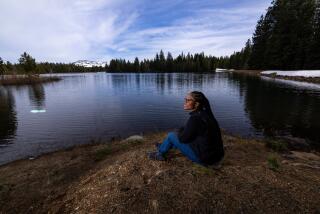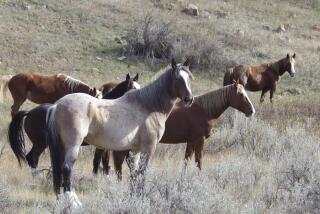Wild horses in San Diego County have storied past, uncertain future
RAMONA, Calif. — Filaree, daughter of Anza and Fiera, is standing in her field — which currently is 140 acres of pasture land in this rural, horse-loving community northeast of San Diego.
Inquisitive, unafraid of visitors and with a gentleness that belies her designation as a “wild” equine, Filaree is among 20 horses in the pasture, all mares and foals. Four stallions, including Anza, are kept in a corral miles away.
DNA testing has shown that the mares and stallions and their recent offspring are descended from horses that carried a Spanish military expedition into the region in the mid-1700s. Their history is intermixed with the triumphs and tragedies of early California.
But though their past is storied, their future is uncertain, possibly dependent on the wild-horse policies of the federal Bureau of Land Management.
“These horses are no different than the grizzly bear, the mountain lion and the wolf — they’re our heritage,” said Kathleen Hayden, a member of Coyote Canyon Caballos d’Anza, a group dedicated to protecting the small herd.
Hayden’s group and the county Board of Supervisors would like the BLM to take responsibility for the horses and relocate them to BLM land near Beauty Mountain in San Diego County.
“They’re gorgeous,” said Supervisor Dianne Jacob, an experienced rider.
For the last year, the horses have lived on a privately owned spread, foraging for grass and occasionally receiving a bale of hay. But long term, the best chance for the herd to survive and increase its numbers lies in support from the federal government, Hayden said.
But nothing involving wild horses and federal policy is simple or without strong passions on all sides.
John Kalish, field manager for the BLM office with responsibility for San Diego and Riverside counties, said that while he too finds the horses beautiful and wants them to survive, his agency does not think relocation is the answer.
“We feel it’s unrealistic to release these horses back to the wild,” Kalish said.
The two areas mentioned by Hayden’s group, he said, would not work. There is not enough forage and water in Coyote Canyon, and the Beauty Mountain area is too close to developed areas.
“The horses would most likely range out to private land or the [Anza-Borrego] state park,” he said.
What’s more, Kalish said, the horses of Ramona have been adopted, which erases the BLM’s responsibility. The U.S. Fish and Wildlife Service has taken a similar hands-off attitude toward Filaree and the other Coyote Canyon heritage horses.
Hayden’s group disagrees with both agencies’ interpretation of their duties under federal law meant to protect wild horses.
Filaree’s long-ago relatives were there when Father Junipero Serra built his mission in San Diego in 1769 and when the Indians staged a massacre near Warner Hot Springs in 1850.
Some of the horses were herded by the Indians into Coyote Canyon on the edge of Anza-Borrego Desert. The horses were not discovered there by the Bureau of Land Management until 1974.
A study by UC Davis veterinarians in 2003 concluded that the herd was malnourished and on the verge of death. The horses were declared feral and invasive and a danger to native species.
Using helicopters, wranglers hired by the BLM rounded up the last 29 of the horses and trucked them to a sanctuary in South Dakota.
The 2003 roundup, which caused a number of pregnant mares to lose their foals, mobilized Hayden and other horse-lovers in the county’s backcountry into action.
“I’m just an old cowgirl from Idaho,” said Hayden, 69, as Filaree and a “watch-burro” named Brigette Berdu approached.
Hayden and others were able to rescue four stallions, including Anza. In 2009, Hayden’s group persuaded the BLM to ship to a private ranch at Borrego Springs 14 mares from a herd in southern Utah that shares the same bloodline as the Coyote Canyon horses. Among that group was Fiera.
A year ago the horses were transferred to Ramona, on private land already set aside for a population of burrowing owls.
The county Board of Supervisors in June endorsed a resolution urging the Bureau of Land Management to devise a plan to relocate the Coyote Canyon horses to federal land under the 1971 Free Roaming Wild Horse and Burro Act.
Not as large as the thoroughbreds at Del Mar, or as dramatic in their galloping as the famous mustang, the Coyote Canyon horses have what horse-lovers call a square conformation. The most common colors are chestnut brown, red dun and black roan.
In the pasture are 17 mares and three foals, with one more foal on the way. Neighbors watch over the herd for any intruders.
If the neighbors are too busy, Brigette Berdu is on duty. She trails the herd and watches for any visitors who slip beneath the barbed wire.
“She’s not going to let anything happen to ‘her’ horses,” Hayden said. “She knows how important they are.”
More to Read
Sign up for Essential California
The most important California stories and recommendations in your inbox every morning.
You may occasionally receive promotional content from the Los Angeles Times.










